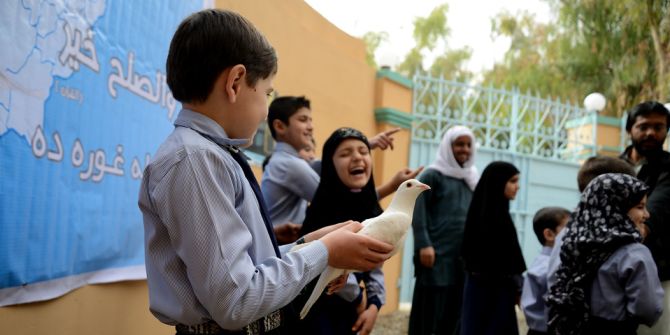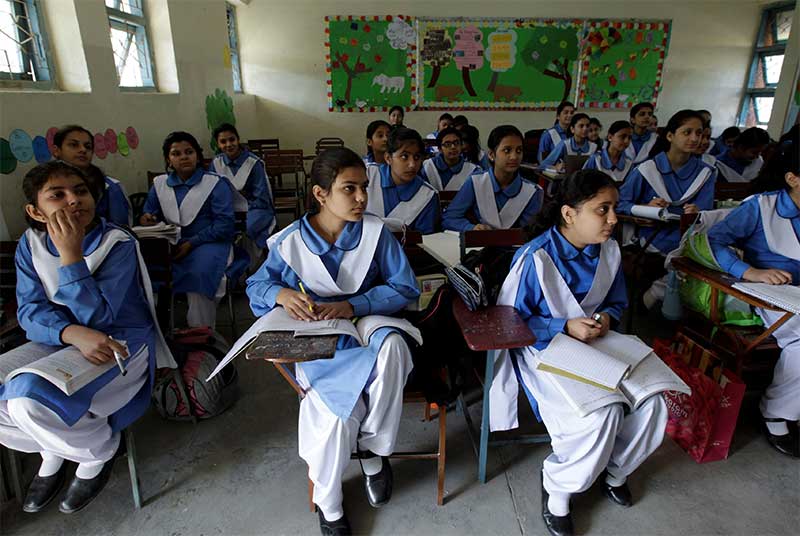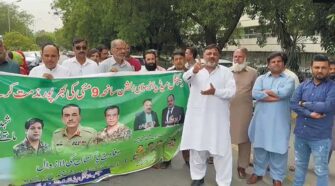By: Asif Khan and Zain Sadiq
 It has been a half-century now when there was stability in Afghanistan last time. Afghanistan is called the graveyard of superpowers, and for this reason, they are dragging each other in this ground from the time the world was bipolar. After that same region was used as a ground for the so-called “war on terror,” an American campaign against terrorism. There have been several attempts to make the region stable by bringing in peace, but none of them has been succeeded. The presence of terrorist groups within the territory of Afghanistan is the biggest challenge for afghan administration. Almost five years ago, there was a possibility that the death of Taliban leader and the outbreak of that news will weaken the position of this group. Nevertheless, in contrast to this opinion, but somehow the Taliban had managed to maintain their strength and power even there was unity among them anymore. One more influencing group was headed by descendants of Mullah Omar, the same group which advanced the peace talks. Even after the problems within the Taliban, they were strong enough to challenge the authorities, and the administration was not able to tackle them. There have been several attempts to engage the Taliban in this whole procedure, but all went in vain. After all these efforts, the afghan administration decided to engage the main stakeholders and prominent players into the process to get immediate results and advance the negotiations more dramatically. After this decision, there was a visible change in negotiations, as all the essential players were making efforts and trying to preserve their interests. (Fellaba-Brown, 2015)
It has been a half-century now when there was stability in Afghanistan last time. Afghanistan is called the graveyard of superpowers, and for this reason, they are dragging each other in this ground from the time the world was bipolar. After that same region was used as a ground for the so-called “war on terror,” an American campaign against terrorism. There have been several attempts to make the region stable by bringing in peace, but none of them has been succeeded. The presence of terrorist groups within the territory of Afghanistan is the biggest challenge for afghan administration. Almost five years ago, there was a possibility that the death of Taliban leader and the outbreak of that news will weaken the position of this group. Nevertheless, in contrast to this opinion, but somehow the Taliban had managed to maintain their strength and power even there was unity among them anymore. One more influencing group was headed by descendants of Mullah Omar, the same group which advanced the peace talks. Even after the problems within the Taliban, they were strong enough to challenge the authorities, and the administration was not able to tackle them. There have been several attempts to engage the Taliban in this whole procedure, but all went in vain. After all these efforts, the afghan administration decided to engage the main stakeholders and prominent players into the process to get immediate results and advance the negotiations more dramatically. After this decision, there was a visible change in negotiations, as all the essential players were making efforts and trying to preserve their interests. (Fellaba-Brown, 2015)
Peace Talks; Quest for Solution
 The peace process in Afghanistan has been full of complexities, as many factors are influencing it. The peace process, which was started almost five years ago by the administration, had many episodes. However, it became effective only when the government realized that there is no hardcore solution to bring stability in the region, so talks and negotiations are the last resort. There were many phases of negotiations which were often proved useless by some reason or incident. After that, a group of Quadrilateral assembly was established to boost up the advancement in the procedure and effective progress. The administration decided to initiate a peace process that was facilitated by the previously discussed group in 2016 to ensure peace and tried to engage the Taliban into a peace process as without their presence; it would have become futile. After a long struggle for peace, all the parties were finally in a position where a direction was clear which they have had to follow, both sides put their demands on the table and decided formality terms and conditions for further advancement in the procedure. (Kazman)
The peace process in Afghanistan has been full of complexities, as many factors are influencing it. The peace process, which was started almost five years ago by the administration, had many episodes. However, it became effective only when the government realized that there is no hardcore solution to bring stability in the region, so talks and negotiations are the last resort. There were many phases of negotiations which were often proved useless by some reason or incident. After that, a group of Quadrilateral assembly was established to boost up the advancement in the procedure and effective progress. The administration decided to initiate a peace process that was facilitated by the previously discussed group in 2016 to ensure peace and tried to engage the Taliban into a peace process as without their presence; it would have become futile. After a long struggle for peace, all the parties were finally in a position where a direction was clear which they have had to follow, both sides put their demands on the table and decided formality terms and conditions for further advancement in the procedure. (Kazman)
Now when the peace deal is done, it is important to mention the role of the High Peace Council in the success of negotiations, which was restored by administration. Administration invited all the participants of peace directly into meetings for the sake of more effective sessions. Neighboring country Pakistan presented itself as a mediator and offered its hospitality. It was demanded from insurgents to stop violence and acts of ferocities so that negotiations can advance positively and effectively. It was made clear that all the offers were only for those who are willing for stability and not for terrorists. After the armistice by insurgents, space for peace was created, which led to the 2020 Peace Deal. (Fellaba-Brown, 2015)
State that played their role in negotiations:
There are many local and international players involved in Afghanistan’s peace process and influencing it in one way or another as they all have direct or indirect interests in Afghanistan. Some of the main actors in the Afghan peace process are discussed here:
United States of America:
If we look upon some recent developments in Afghanistan, one cannot ignore the efforts of the American military and its allies in the development of Afghan National Security by enhancing their capabilities. The United States of America wants to facilitate the war rotten Afghan region in every necessary field. It expects the international community to do the same for the development of improved, enhanced, and effective national security systems in order to tackle any misadventure in the future. It is believed that the Taliban are not trustworthy enough that one should give them freehand and freedom without any preparation and backup plan. In late 2016, the American administration announced that they are ready to cooperate with the Taliban and recognized the insurgent group as an important participant of negotiations; to gain the trust of the Taliban U.S also stepped back from aggression against Taliban for the sake of peace procedure and expected same from them. This was a very bold and brave step by the United States administration, which later proved to be very effective and fruitful. This offer of armistice and peace by the U.S was for all, but some fundamentalist and stubborn group did not avail the opportunity and continued to create violence and terrorism. This particular plan later appeared as an obstacle in the peace procedure because some non-participant groups were powerful enough to cease the peace process like the Haqqani group. (Kazman, 2016)
Russia:
Russia and Afghanistan have had no good memories in the recent past, and the role of Russia was that of evil in this region and a nightmare for afghans. It was Russia who laid the stone of instability in Afghanistan. Opposite to the previous record, now Russia is working for development in Afghanistan, and the main subjects are economy and infrastructure. Neighboring state Russia is concerned about the law and order situation in Afghanistan as its stability is very crucial for the betterment and security of the region. Another concern is the drug market in this region, as Afghanistan is a haven for dealers and investors. With America being head of the peace process, there is not much for Russia. However, it is concerned about the role of the Taliban and their stance in the future; the hegemony of the Taliban will promote the fundamentalist approach and Islamic jihadism, which is the biggest potential threat to Russia. With the presence of America, Russia is not even in a position to deploy its forces inside Afghanistan, and the best they can do is to secure their border with Afghanistan. Moscow is unhappy with the Taliban hold in the region, and in this regard, they are supporting a very anti-Taliban group by any means. They are trying their best to equip enemies of the Taliban by using all resources, including arm supply and strategic assistance. Narcotics business is also a reason for instability in the region creating troubles and illegal money being used for political instability.
Although Russia is not very much pleased as it is brutally ignored in the peace process despite being the major power of the region as well as the world. However, they have carried some proceeding on their own by trying to engage the Taliban in negotiations and making them agree for an armistice as it was the only way towards stability.
China:
Along with other stakeholders, china is also a significant player in terms of the future of Afghanistan, as the rotten war country is looking forward to achieving stability and prosperity, their biggest hope is china. Also there are interests of china in this region. There are two faces of china’s interest coin, one is the economic expansion and getting hold of the region for trade purpose, and second is for stability within china as border region of Afghanistan is a safe zone for terrorists and being used against China. The main reason behind china’s involvement in the resources of Afghanistan as it is called Saudi Arabia of Lead and Copper. This region is also rich in some other minerals. China is also starting projects in the power sector to fulfill the needs of Afghanistan and aiding in technology. It is also working on including Afghanistan in its Belt and Road initiative by its extension called Wakhan Corridor. China is also trying to keep good terms with the United States of America as it is the most influencing player in the region, and china cannot play against its will.
Now when America is creating a vacuum gradually, china is not wasting time in filling it. It is trying to develop good terms with Afghanistan as it is the second biggest stakeholder after America. China is moving one step further by engaging the Taliban into the mainstream on their own, along with creating good relations with the Afghan administration. In this regard, Head of State Mr. Ghani has the biggest contribution by making all this possible in association with Pakistan and China. President Ashraf Ghani has been working for Beijing pleasure. In this regard, he has allowed to handover insurgents residing in Afghanistan and causing disturbance in china to the administration of Beijing. China has also appointed some experts of regional subjects in Afghanistan to manage the terms and relations in the region. It has also played a role of a mediator between Afghan administration and insurgent groups and carried out productive sessions. Currently, China has also extended its military and fiscal support to Afghanistan. However, the interests of China are very much similar to those of India, and it has also to consider the stance of Pakistan and its policy.
Pakistan:
Pak afghan relations had faced massive changes in nature since 2014 when Ashraf Ghani took charge of Afghanistan. He accused Pakistan of insurgencies inside Afghanistan and doubted its commitment for peace deal. Ashraf Ghana is not a supporter of Pakistan, yet he cannot deny the role of Pakistan regarding the peace process. The involvement of Pakistan is significant in peace negotiations as it is the only player on whom the Taliban can trust, and they can engage them in the procedure. Pakistan also wants to have hegemony in the region because the vacuum will leave a friendly environment for the pro-Indian government to flourish. The main concern of Pakistan is to counter the threat caused by Indian presence in its neighborhood as the adjoining border with Afghanistan makes Pakistan very much vulnerable. Pakistan can prove its sincerity by bringing the Taliban into the peace process and insisting on them for consensus. Ball was in the court of Pakistan, and it played it well by agreeing to convince the Taliban. However, Pakistan has urged that it has certain limitations in order to put pressure on the Taliban. Although the Taliban did not want to rely on Pakistan entirely and established its structure. An increase in terrorist activities has also put a question mark on Pakistan’s role, as the number rapidly increased after the initiative of the peace process.
Iran:
Stable administration in Afghanistan is also in favor of Iran as its shares border and impact on its region. The main concerns of Tehran Iran are stability in the region and an increase in strength of the Taliban as it is contradictory to the ideology of Iran on a limited basis. The role of Iran in the northern alliance is also vital. Another major problem being faced by Iran is a refugee crisis. Afghan locals had moved into neighboring states when war broke out in the region and also burdened Iran with over 2 million refugees; another problem following the refugee crisis is drug trafficking, which is destroying the Iranian market.so the interests of Iran are only preserved when there is stability in Afghanistan. Back then, there was the hope of Washington and Tehran working in collaboration when a peace deal was done. However, recent developments have destroyed the developments after the assassination of General Soleimani. Now the tensions are increased, and both states must play their part on their own.
India:
The neighboring country India is afraid of Afghanistan being the hub of fundamentalist jihadis who are ideologically against it. India is acutely aware of the fact that the Afghan Taliban are pro Pakistan, a conventional adversary of it, power in the hands of the Taliban is a potential danger for Indian interests. Somehow, the mentioned points cannot be falsified. Thus, it would be beneficial for India if the administration in Afghanistan is cooperative and makes sure to eradicate anti-Indian factors. Instability in Afghanistan would pave the way for anti-India elements, which is against their interests. That is why it is at the front foot in Afghanistan in terms of service provisions and facilitating other utilities. Hegemony of one state increases the concerns of others and with India being so active in Afghanistan. There is a potential threat to the control and stability of Pakistan. As we know that the most crucial group in these peace negotiations is the Taliban, and it is inclined towards Pakistan as there is an opinion that the Afghan Taliban is the brainchild of Pakistan. Though the administration of Afghanistan and their officials said, the role of India is inevitable as it is totally in charge and being briefed on every development.
Challenges:
QCG’s new peace plan has included many holes and obstacles, which should be dealt with cautiously. Those challenges are:
>As we all know, the Taliban have now further subdivisions, so the administration should be careful when dealing with them to get engaged with the right group; the government should have a backup plan if they find insurgents not cooperative.
>The second challenge these peace negotiations are facing is that up to what extent both these groups are ready to agree on a single agenda and how many points of contradictions there will be?
>The third challenge in this regard would be the constitution. As both groups are bound to two different sets of rules, so this is the most significant point of divergence that which group will show some flexibility as government fallows national rule, and insurgents are admirers of Islamic law.
>The fourth issue being faced by stakeholders in the peace process is that what will be the status of unprivileged people like religious minorities and women as Taliban have some other sort of rules for them in place of equality.
>One more grave issue is that what role the neighboring state of Pakistan will play and how much sincerity can be expected from it. Though they have the same religion in common, still national interest are given priority. So, the administration must be very much conscious about this issue.
>The most challenging issue in this context is how both parties are going to trust in each other, will insurgents’ groups stop insurgencies as soon as negotiations start or not? What will be the strategy of administration if the Taliban refuse to armistice? (Giustozzi, 2010)
Recent Developments:
In the last few years, there was no advancement in negotiations, and it is at freeze [ administration has chosen Hekmatyar as head of the delegation. Opening meeting between Taliban and government officials was held in January. However, the administration is not considering this episode as a milestone, the administration is still optimistic that the Taliban will join the process, and there will be positive progress.
Now the neighboring country, who is having so much in common with Afghanistan, including religion, has refused to insist Taliban for negotiations. Afghan administration has decided to engage regional power china and world power America in the peace process for effective advancement. Following the decision, now there is hope and chances of stability in the region after a long deadlock. (Rutting, 2016)
While the insurgents are actively involved in increasing tensions and pulling strings, indicating that there will be no result of these efforts. On 28 March 2016, insurgents made a clear message that peace initiative is over from our side by firing rockets at the capital city and legislation house. The safety of the country had become very much vulnerable as governments refused to provide arbitrary force to the target, which was under attack in the past several times. The head of Afghan security accused the intelligence agency of Pakistan of these attacks. Following the previous attacks, there were more insurgencies in the capital city, which left hundreds dead and wounded, and primary victims were ordinary people. The hostile party took the responsibility of terrorism, which was just after the declaration of stringent measures against the government. After this event, the administration decides to take appropriate measures against insurgent groups and will show no tolerance. They also made clear that peace negotiations are not for those who are into any kind of terrorism.” Till then, the chances of stability are facing uncertainty. (“Enhancing Security and Stability in Afghanistan, October 2014)
Conclusion:
In the past, the biggest hurdle in the way of stability in Afghanistan was the insurgent group Taliban. Nevertheless, now, when peace is ensured in an agreement between the U.S and Taliban, there is no more threat of violence and disturbance. Administration and the Taliban both have their versions. Both players in Afghanistan are hoping for the future to be following their desires, as there are fundamental contradictions between both schools of thought regarding very crucial subjects of society. Also, there is no hope of consensus in this regard. Moreover, neighboring countries of Afghanistan are also intervening according to their interests. Now when peace deals are done, there are more chances of prosperity in the region if the stakeholders play there part sincerely. After the peace deal, Afghanistan is now on its way towards stability, and soon, people will enjoy peace at home. Moreover, stability will bring business back, and Afghanistan will make rapid progress because of its geopolitical location. (Tiwary, 2016)









